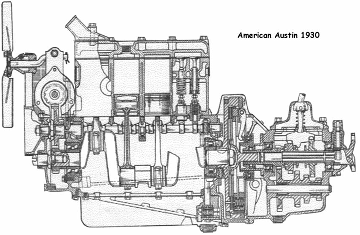
The English Austin engine of which the American Austin engine is a version, is certainly one of the very pillars of world automotive history. More of the legendary names of people and marques we are familiar with, particularly in racing and design history have logged time behind the wheel of, in the innards of, or designing frames and bodies for these little 750cc flathead four bangers. BMW's first car the Dixi featured one. William Lyons built his Swallows (later Jaguar) around and Austin 7. Hailwood, Clark and Moss, to name only a few won their first races in them. Colin Chapman raced and modified them. One of the most popular classes of racing in England, the 750 formula used these engines exclusively until about 15 years ago when they became so rare that the designated engine was reluctantly shifted to the Reliant (still and Austin derivitive.) Even this month (Jan 99) we read in Classics and Sports Cars of two beautiful little Austins making winning runs from Paris to Marakesh in Rallyes.
So, if you are struggling with the reassembly of one of these engines, keep this in mind. The engine was designed as an evening moonlighting job on Herbert Austin's pool table by and eighteen year old draughtsman in 1921. (Stanley Howard Edge). Edge's inspiration came from a small Peugeot of the time, and some of the features of the Belgian FN motorcycle were also employed.
_______
The original American Austin engine was licenced from Austin in 1929. The American versions are a "mirror image" of the English parent, so, some of the parts, like pistons, bearings etc., can be used in English or American engines but the threads of the American units will be SAE of course.

The American version was a 45.6 cubic inch (750cc) four cylinder flathead with 5.0:1 compression.. The main bearings are a cylindrical roller in the back, and a double row of (double annular) ball bearings in front. Very high quality stuff, and indicative of a free running engine, but a little noisy. The whole engine with clutch and all accessories weighs only 148 lbs.

The cars with this engine did get 40mpg, but with 13 horsepower top speed was likely to be around 50, at which one could expect some crankshaft whip and an anguished keening from under the hood. The English have never really understood American preferences in cars, and why the American Austin and Bantam never really succeeded here, but perhaps they would get some insight if they had to slog across west Texas behind one of these little coffee grinders :~).
WHAT DO THOSE NUMBERS MEAN? Norm Booth gave a very complete answer to a person inquiring about the numbers they found on thier Austin engine. This is the sort of great info you can expect to get if you join the Clubs!